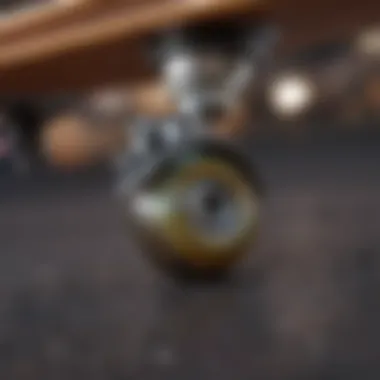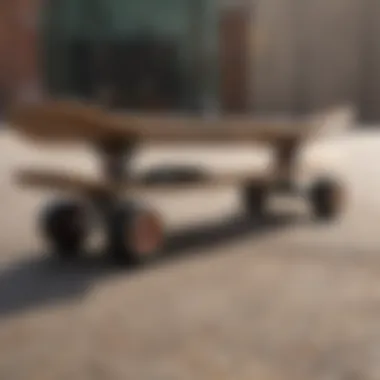Exploring Skateboards: A Guide to Tablas de Skate


Intro
Skateboarding, beyond being a mere hobby, embodies a lifestyle rooted in creativity and self-expression. The tall tales of riders whizzing through urban jungles or carving through skateparks offer a glimpse into a world where the skateboard—known in many circles as tablas de skate—stands as both a tool and a canvas for artistic endeavors. From the way the wheels spin to how a deck flexes, every element plays a part in the narrative of skate culture.
This guide takes a close look at the many facets of these wooden boards that have captured hearts and minds since their inception. Here, we’ll explore different types of skateboards, their materials, and design characteristics, as well as dive into maintenance tips to keep them in optimal shape. Skateboarding is also about community; it carries a rich cultural significance that we’ll uncover as we move ahead.
Whether you're a seasoned skater or just beginning to carve the pavement, understanding your board is key to elevating your skills and enhancing your appreciation for the sport. So, let’s roll on into the nitty-gritty of tablas de skate.
Prologue to Tablas de Skate
Skateboarding is not just about cruising down the street on trendy boards, it's a culture, a lifestyle, and for many, a means of self-expression. This section lays a solid groundwork, exploring the core elements that make tablas de skate, or skateboards, the vessels of freedom for countless enthusiasts. Without a doubt, understanding the fundamentals of skateboards can elevate one’s experience, fostering a deeper connection to the sport.
Definition and Importance
Tablas de skate are more than mere wooden conveys; they embody the essence of various riding styles, from casual cruising to hardcore tricks that defy gravity. Simply stated, a skateboard consists of a deck, trucks, wheels, and grip tape—each component serving a distinct purpose, contributing to the overall performance.
Grasping the different parts and their function is crucial for anyone looking to venture beyond basic riding. It’s not just about picking a board; it’s about choosing the right tools that align with individual style and preferences. A well-crafted skateboard can profoundly affect the ride quality, influencing speed, maneuverability, and even the tricks one can perform. In a sense, one’s skateboard becomes an extension of the rider themselves, a partner in the dance of balance, speed, and style.
History of Skateboarding
Skateboarding's history is as rich and textured as the streets it's been birthed upon, tracing back to the late 1940s and early 1950s when surfers in California, looking for the thrill of wave riding on land, first began to create makeshift skateboards. They used wooden boxes and roller-skate wheels, setting the stage for a new wave of recreation. As the years rolled on, from the rough concrete of empty pools in the 1970s to the polished floors of urban landscapes, skateboarding evolved.
By the 1980s, the introduction of more advanced materials and designs emphasized innovation. Decks became wider and more concave, allowing for tricks and stunts that turned ordinary sidewalks into skate parks. This decade birthed some of the most infamous skateboard companies, such as Powell Peralta, and skaters like Tony Hawk, leaving an indelible mark on the sport. Today, skateboarding is celebrated worldwide, competing in major sporting events and influencing fashion, music, and street art.
"Skateboarding is a way to express yourself—your thoughts, your ideas, your identity. It's a reflection of the freedom to innovate."
In essence, understanding the history not only honors the tradition but also helps new skaters tap into a well of inspiration and community spirit—a reminder that every board rolled out today is a part of a much larger narrative.
Components of a Skateboard
Understanding the components of a skateboard is pivotal for anyone invested in the sport or culture. Each part has its own role, directly impacting performance, feel, and maneuverability. If you’re just getting your feet wet or looking to upgrade, knowing what makes up a skateboard can dramatically elevate your riding experience. Skaters often discover that personal preferences dictate not only the choice of boards but also how well they perform in different environments and styles. By delving into each component, we can gain insights into what to prioritize when selecting the perfect setup.
Deck: The Core Element
The deck serves as the foundation upon which every skateboarder stands. It’s the largest component, often crafted from layers of wood or other materials that lend themselves to versatility and durability.
Material Choices
When it comes to material choices, especially for the deck, most skateboards are made from maple wood for its stiffness and resilience. This wood type aids in providing the necessary pop for tricks. Some brands even try using bamboo or carbon fiber, which can offer different flex patterns and weight distribution.
A notable feature of maple is its ability to absorb shock, making landing from jumps less brutal on the knees. However, one downside is the susceptibility to chipping or breaking under extreme stress. For those who need durability, something like bamboo could indeed be a beneficial choice although it might not provide the same pop as maple.
Size and Shape Variations
Deck sizes and shapes play a big role in skateboarding. A wider deck provides more stability, making it suitable for beginners. On the flip side, a narrower deck allows for better trick response, catering to advanced skaters. Whether you are looking to carve through tight spots or prefer larger boards for stability during long rides can influence your choice significantly.
Unique shapes can also affect performance. For instance, a concave deck can enhance control during tricks but might be less comfortable for beginners. Ultimately, the choices made in deck size and shape reflect personal style and intended use on the board.
Trucks: The Turning Mechanism
Trucks act as the turning mechanism for a skateboard, connecting the wheels to the deck and allowing for responsive steering – a crucial element in skating. The type and quality of trucks significantly contribute to how well one can maneuver.


Types of Trucks
The two main types of trucks can be categorized as standard and inverted. Standard trucks are the traditional set-up, commonly favored for their reliability. Inverted trucks, however, can offer improved grinding and stability, especially for skateboarding in parks.
One of the unique features of trucks is the height. Low trucks often provide better stability, while high trucks can enhance clearance for certain tricks. Choosing the right type of truck must align with your skate style to ensure the best performance.
How They Affect Ride
The angle of your truck can alter your riding experience, more specifically, affecting the responsiveness of turns. A higher angle truck will generally allow for sharper turns but may feel less stable when skating fast. Conversely, lower-angled trucks can give a stable ride but a bit less agility. Each skater will have to balance these factors based on their specific preferences, making truck choices deeply personal.
Wheels: The Contact Point
Wheels are the contact point between the skateboard and the ground, playing a critical role in speed and control. The material and durometer ratings are key components when selecting wheels that suit one’s skating style.
Wheels Materials and Durometers
Most skateboard wheels are made from a urethane compound which offers a good balance of grip and durability. The durometer scale measures hardness, with a lower number indicating a softer wheel that grips better but wears down quicker.
For street skating, softer wheels are often favored. They absorb bumps better, making them ideal for uneven surfaces. In contrast, harder wheels, while less grip-y, provide greater speed on smooth surfaces, showing that both types have their unique advantages depending on the terrain.
Effects on Performance
A skateboard's performance hinges significantly on its wheels. Softer wheels can give a smoother ride, preventing those nasty jolts when rolling over cracks. Conversely, harder wheels can slice through urban landscapes and offer faster speeds, but can be brutal when it comes to rough surfaces.
Types of Tablas de Skate
Understanding the different types of skateboards is pivotal for anyone keen on navigating the thrilling world of skateboarding. Each type serves its own unique purpose and is tailored to various styles of riding, offering distinct benefits and a personalized experience for skaters. Whether it’s cruising down the street or tackling a vert ramp, knowing which type of tabla de skate suits your needs can elevate your enjoyment and proficiency.
Standard Skateboards
Standard skateboards are the most commonly recognized in the skating community. Typically decked out in a 7.5 to 8.5 inch width, they provide a solid foundation for tricks and technical maneuvers. The classic shape features a slight curvature, allowing riders to pop tricks more effectively and land with stability.
When considering a standard skateboard, think about your skill level. Beginners might opt for wider boards for better balance, while experienced skaters may prefer narrower boards to launch into flips and spins more easily. The standard skateboard lends itself to a myriad of styles, making it a versatile choice for many skaters.
Longboards
Longboards cater to a different realm of skateboarding, favoring stability and comfort over technical tricks. Usually measuring between 33 to 59 inches, these boards feature wider decks that accommodate a relaxed cruising style, perfect for downhill rides or commuting.
The key advantage of longboards lies in their design; they often include longer wheelbases and larger wheels which minimize road shock and provide a smooth ride. For those looking to ride long distances or simply cruise, a longboard is a solid companion. However, if you’re itching for a session in the skate park, you might find yourself reaching for a standard skateboard instead.
Cruisers
Cruisers bridge the gap between standard skateboards and longboards, giving riders an optimal blend of maneuverability and comfort. Generally shorter than longboards, typically around 28 to 32 inches, cruisers are designed for easy transportation and casual riding around town.
These boards often come with softer wheels that facilitate a surprisingly smooth ride over bumpy surfaces. If you fancy navigating through city streets or running errands while still catching a few tricks here and there, a cruiser might be just what you need. Its lightweight nature allows for portability, making it easier to carry around.
Decks for Specific Stunts
For those who are serious about skateboarding tricks, specialized decks like street and park boards are essential. These boards are crafted for certain stunts, ensuring they’re both lighter and reinforced for durability. The dimensions vary but often feature a flatter profile which enables better balance during tricks.
Skateboarding aficionados will use these decks for everything from grinding rails to flipping decks in the air. Choosing a board specifically designed for stunts can significantly enhance performance while reducing the risk of breakage during high-impact use. Skaters should be on the lookout for features like more robust materials and precision trucks, as this can have a huge impact on executing tricky maneuvers successfully.


"The right skateboard can make or break your experience on the board. Choose wisely!"
As you navigate the world of skateboarding, remember that finding the right type of tabla de skate not only enhances your riding experience but also helps you grow as a skater. Understand your goals, test different types, and let your style define what kind of board you truly resonate with.
Design Trends in Skateboards
Design trends in skateboards reflect more than just aesthetics; they embody the evolving culture of skateboarding and its community. Each new trend signifies a blend of creativity and functionality, showcasing how skateboarding is both an art form and a sport. In recent years, the focus has shifted towards not only making skateboards look good but also integrating innovative features that enhance the riding experience. Different trends arise from various influences, including art, social movements, and technological advances.
When examining design trends, it’s important to consider how these skateboard elements make an impact on the skateboarders themselves. A well-designed skateboard can boost confidence, making trick attempts more manageable while allowing for self-expression. With the skateboarding community becoming increasingly diverse, the demand for unique designs that cater to individual tastes is growing.
Graphics and Aesthetics
Graphics play a crucial role in setting the tone for a skateboard. From minimalist designs to vibrant illustrations, the aesthetic appeal of a board often draws skaters in. Various artists and graphics designers collaborate with skateboard brands to create visually striking graphics that resonate with specific subcultures within skateboarding. Sometimes, these graphics tell a story or signify belonging — a badge of honor of sorts.
Several trends have been noted:
- Hand-Drawn Artwork: Skaters are drawn to boards that showcase unique, hand-crafted artistic designs. This trend emphasizes authenticity and connection to grassroots art movements.
- Bold Colors: Bright colors and patterns are increasingly popular. Bright boards are not just eye-catching; they can also reflect personal style and generate a fun vibe.
- Retro Themes: Nostalgic designs inspired by the 70s and 80s are making a comeback. These designs evoke fond memories and appeal to both older skaters and new enthusiasts looking for a touch of history.
These graphic choices allow riders to express themselves, making each board a personal statement as well as a functional piece of equipment. In a community where individuality is highly valued, the visual aspect of skateboards carries significant weight.
Technology Integration
As the skateboard industry evolves, technology becomes more intertwined with design, paving the way for innovative solutions that improve skating experiences. Technology integration includes various aspects, from materials used in construction to smart features that aid performance.
- Advanced Materials: The use of composite materials, like fiberglass and carbon fiber, is gaining traction. These materials not only enhance durability but also allow for lighter boards, meaning skaters can perform tricks more easily.
- Smartboard Technology: Features like built-in sensors for speed and balance are emerging. These boards can collect data about a rider’s performance and suggest improvements, thereby elevating the skating experience.
- Eco-Friendly Innovations: Building sustainable designs is becoming a priority. Brands are introducing skateboards made from recycled materials, contributing to a greener planet. Environmentally conscious designs not only appeal to skaters wanting to minimize their ecological footprint but also highlight the industry's adaptability.
The fusion of technology and design showcases the industry's commitment to improving performance while reflecting a conscious attitude towards the environment and social trends.
As skateboarders and enthusiasts explore these design trends, they find that modern skateboards serve not only as tools for sport but also as canvases for self-expression and sustainability. Each design, whether it be aesthetic or technological, contributes to the rich tapestry that is the world of skateboarding.
Cultural Significance of Tablas de Skate
The world of skateboarding runs deeper than just tricks and flips on a wooden plank. It's a subculture that pulses with energy, creativity, and, perhaps first and foremost, a distinct sense of identity. Tablas de skate are not merely tools for transportation or sport; they are expressions of individuality, freedom, and rebellion. By exploring the cultural significance of skateboards, we uncover layers that highlight their importance in both society and personal realms.
Symbol of Freedom and Expression
For many riders, their skateboard signifies more than a way to cruise down the street; it represents freedom—the very essence of skateboarding. From the chaotic skatepark to the smooth asphalt of urban environments, a skateboard provides the means to navigate and express oneself in a world that can often feel restrictive.
This freedom manifests itself in various forms:
- Personal Style: Each rider often customizes their board, making it a unique extension of their personality. From vibrant graphics to specific deck shapes, the choices one makes reflect their personal aesthetic—turning a simple board into a canvas of creativity.
- Community and Belonging: Skateboarding fosters connections among individuals who share a common passion. This tight-knit community thrives on the values of mutual support and shared experiences, allowing skaters to express themselves without fear of judgment.
- Breaking Boundaries: Skateboarding transcends societal norms. It allows individuals to challenge rules and create their own paths—physically on the board and metaphorically in life. This rebellion against conformity is a cornerstone of skate culture, where doing your own thing is not just accepted but celebrated.
As skateboarders carve through streets or fly off ramps, they often carry this philosophy of freedom and expression into their everyday lives.
Influence on Fashion and Music
The cultural impact of tablas de skate extends beyond the board itself; it profoundly shapes fashion and music trends. In recent decades, we’ve seen skateboarding infiltrate mainstream culture in ways that were once unimaginable.
Fashion Impact
- Streetwear Evolution: Iconic skate brands like Thrasher, Supreme, and Vans have reshaped the fashion landscape. Skate-inspired tees, hoodies, and sneakers are now must-have staples; they emphasize comfort, durability, and style.
- Youth Culture Icon: Wearing skate brands has become a way for many young people to assert their identities, signaling an affiliation with the skate community and its values.


Musical Landscape
- Soundtrack to the Scene: Skateboarding and its associated music genres, like punk and hip-hop, are inextricably linked. Skate videos often feature soundtracks that reflect the spirit of rebellion and community that skateboarders embrace.
- Influence on Artists: Many musicians who ride and identify as skaters incorporate their experiences into their music, further enriching the tapestry of skate culture and reinforcing its ideals.
The melding of skateboarding with fashion and music showcases a vivid cultural exchange, where each influences the other, creating a unique blend of lifestyle and art.
Maintenance and Care for Skateboards
Maintaining a skateboard properly ensures not only its longevity but also the safety of its rider. Skateboarding is not just a sport; it’s a way of life. To get the most out of your experience, paying attention to the upkeep of your skateboard is critical. Riding with a well-maintained board enhances performance and keeps you safe from potential injuries caused by equipment failure. This section will cover the routine inspections necessary to keep your skateboard in top shape, common problems you might face, and smart storage tips to prolong its lifespan.
Routine Inspections
Routine inspections are akin to giving your skateboard a health check-up. A few minutes spent checking key components can save you a lot of hassle in the long run. Here’s what to keep an eye on:
- Deck: Inspect for cracks, chips, or any signs of delamination. A compromised deck could jeopardize your balance and control.
- Trucks: Ensure they are not loose. Tighten the bolts if they wobble. Pay attention to the pivot cup, too, and replace it if it looks worn out.
- Wheels: Look for flat spots or signs of wear. If they don’t roll smoothly or are uneven, it’s time to swap them out.
- Bearings: Keep an ear out for grinding noises. Clean and lube them regularly to maintain optimum performance.
Regular checks create a habit that can help you spot issues before they become serious. "An ounce of prevention is worth a pound of cure" rings especially true for skateboards.
Troubleshooting Common Issues
Sometimes, even with the best care, issues pop up. Here's how to tackle them:
- Wobbly trucks: If your board wobbles while riding, check the mounting hardware. Tighten any loose bolts.
- Slow wheels: If your wheels aren't rolling freely, remove them to clean the bearings. Dust can build up and hinder performance.
- Deck grip peeling: If the grip tape is peeling or worn, it might affect your footing. Replace it to ensure you have the best traction.
- Noisy bearings: If the bearings make noise, clean and lubricate them. If they’re still noisy after cleaning, they might need replacing.
These troubleshooting tips are vital for all skateboarders. Knowing how to solve common issues not only keeps your board riding smooth but also saves time and money.
Storage Tips
Proper storage can drastically extend the lifespan of your skateboard. Here are a few pointers:
- Dry Place: Keep your board in a dry area to prevent wood warping and rusting on metal parts.
- Use a Wall Rack: Storing your board vertically can avoid pressure on the wheels and trucks, maintaining their shape.
- Avoid Direct Sunlight: Too much sun can bleech the graphics and weaken the board.
- Protective Bag: Consider stowing it in a protective bag if you’re traveling.
When you take care of how and where you store your skateboard, you're investing in its future. Proper maintenance goes a long way in ensuring that your riding experience remains enjoyable and safe.
The Future of Tablas de Skate
The future of tablas de skate is not just a passing fancy; it’s a pivotal aspect for both skateboard manufacturers and enthusiasts. Every new trend and innovation blooms from necessity, creating alternative solutions for various riding styles and user preferences. Speculating about what lies ahead, we can focus on specific elements such as emerging materials, inventive technologies, and a never-ending quest for greener solutions. These aspects will not only shape the equipment itself but also influence the very culture and lifestyle surrounding skateboarding.
Emerging Materials and Technologies
As we step into the coming years, skateboard forms are expected to evolve, primarily driven by advances in materials science. Skateboard decks are increasingly being crafted from materials ranging from bamboo to carbon fiber.
- Bamboo: Lighter than traditional maple wood, bamboo offers superb flex and responsiveness, making it ideal for tricks and street skating.
- Carbon Fiber: Known for its strength and lightweight nature, carbon fiber is becoming a popular choice for high-performance boards. Skaters who crave speed and agility will find ultimate satisfaction from this innovation.
Even wheel composition is on the rise with exotic polymers that enhance durability without losing grip. There is talk of shock-absorbing technology to reduce impact when landing tricks, possibly revolutionizing how skaters experience their sport.
Imagine a skateboard that automatically adjusts its flex and stiffness based on the rider’s weight and riding style. This kind of smart technology could very well be around the corner, creating personalized boards that adapt and synchronize with their user’s kinetic motions.
Environmental Considerations
Skateboarding, like many other lifestyle choices, faces scrutiny regarding its environmental impact. The eco-conscious movement within the skateboard community is gaining traction. It's essential for brands to consider sustainable practices in both materials and production processes.
- Sustainable Materials: More manufacturers are exploring the use of recycled materials, such as repurposed plastics and reclaimed wood. These materials can dramatically lower the carbon footprint of production.
- Eco-friendly Paints and Glues: Introducing non-toxic, biodegradable finishes not only protects the environment but also ensures safety for users.
The rising trend of environmentally friendly skateboards might pave the way for more responsible consumption. In this light, keep an eye out for companies promoting eco-awareness alongside performance. Not only will this shift help in sustainability, but it might also cultivate a more responsible skate culture that makes a difference in communities worldwide.
"The skateboard doesn’t just represent a mode of transport; it signifies an ethos of freedom, evolution, and increasingly, responsibility.”
As the industry becomes progressively sensitive to the demands of the modern world, the innovations and environmental considerations shaping the future of tablas de skate will not only satisfy skaters but will also resonate with a broader audience. The next iteration of skateboarding gear could redefine how enthusiasts engage with their sport while enhancing their connection to the world around them.







